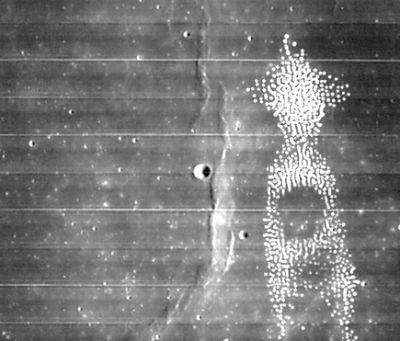Very
Contents
Very
(formerly Le Monnier B)
|
Lat: 25.61°N, Long: 25.33°E, Diam: 4.65 km, Depth: 0.56 km, Rükl: 24 |

LOIV-085-H3 shows Very (central), and Dorsa Smirnov running north-to-south.
Images
LPOD Photo Gallery Lunar Orbiter Images Apollo Images
- The bowl-shaped crater Very and the nearby wrinkle-ridge system Dorsa Smirnov (the Serpentine Ridge) were also captured on Apollo 15's orbital panoramic ITEK-camera frame AS15-P-9315. Very is the largest one of the depicted craters beyond the frame's centre, to the right.
- Very and Dorsa Smirnov are also seen on Apollo 15's orbital Hasselblad photograph AS15-91-12399.
- Much more orbital Hasselblad photographs of Very and Dorsa Smirnov: Apollo 17's AS17-153-23507 (with Posidonius Gamma near the frame's lower margin), AS17-153-23508 (with Luther near the frame's lower margin), AS17-153-23510 (Very near the frame's lower margin), AS17-153-23511 (Very above left of centre).
- Research orbital Apollo 15 and Apollo 17 photography: Danny Caes
Maps
(LAC zone 42B3) LAC map Geologic map LM map LTO map
Description
Wikipedia
Additional Information
- IAU page: Very
- Depth data from Kurt Fisher database
- Westfall, 2000: 0.56 km
- Viscardy, 1985: 0.95 km
Nomenclature
- Named for Frank Washington Very (1852 – November 23, 1927), an American astronomer. His most important work was in measuring the temperature of the surfaces of the Moon and other planets using a bolometer. Samuel Pierpont Langley published in 1890 a widely read paper on the Moon observations, but for unknown reasons omitted Very's name from the list of authors. In 1891, Very published his own paper about the "Distribution of the Moon's Heat," which also included measurements taken during a lunar eclipse.
LPOD Articles
Bibliography
Frank W. Very in the Sourcebook Project (William R. Corliss)
- In Mysterious Universe, a handbook of astronomical anomalies (1979) :
- Page 300: Fall of a Meteorite in Norwood, Massachusetts (Frank W. Very, Science, 1910).
- Page 301: On the so-called Norwood "Meteorite" (Edmund Otis Hovey, Science, 1910).
Named Featues -- Prev: Vertregt -- Next: Vesalius